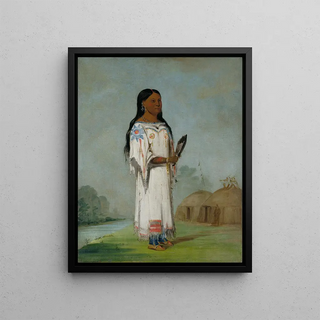Art print | Seet-S-Be-A Midday Sun a pretty girl - George Catlin


View from behind

Frame (optional)
In the vast panorama of art history, certain works stand out for their ability to capture the essence of a particular era and culture. The art print Seet-S-Be-A Midday Sun, a lovely girl - George Catlin, is a perfect example. This canvas, imbued with the dazzling light of midday sun, evokes not only the beauty of a young woman but also the richness of Native American traditions. Catlin, as an artist, invites us to contemplate a suspended moment where nature and humanity meet in delicate harmony. Through this piece, he offers a window into a often misunderstood world, while celebrating the dignity and grace of the subjects he depicts.
Style and uniqueness of the work
George Catlin's style is characterized by a realistic approach and meticulous attention to detail. In Seet-S-Be-A Midday Sun, he manages to create a vibrant atmosphere through warm colors and subtle lighting that highlight the delicate features of the young girl. The artist does not merely reproduce an image; he seeks to convey an emotion, to tell a story. Every brushstroke seems charged with meaning, inviting the viewer to immerse themselves in the moment. The composition, both simple and powerful, emphasizes the natural beauty of the subject while incorporating symbolic elements that evoke Native American culture. Thus, this work transcends a simple portrait to become a true testament to the identity and values of a people.
The artist and his influence
George Catlin, born in 1796, is often recognized as one of the first artists to document Native American cultures through his paintings. His work is set against a historical backdrop where indigenous peoples faced profound and often devastating changes. Catlin, traveling across the United States, was able to capture not only the physical appearance of his subjects but also their way of life, rituals, and beliefs. His influence extends beyond his time, inspiring many artists and historians who see in him a pioneer of visual anthropology. The art print Se

Matte finish

View from behind

Frame (optional)
In the vast panorama of art history, certain works stand out for their ability to capture the essence of a particular era and culture. The art print Seet-S-Be-A Midday Sun, a lovely girl - George Catlin, is a perfect example. This canvas, imbued with the dazzling light of midday sun, evokes not only the beauty of a young woman but also the richness of Native American traditions. Catlin, as an artist, invites us to contemplate a suspended moment where nature and humanity meet in delicate harmony. Through this piece, he offers a window into a often misunderstood world, while celebrating the dignity and grace of the subjects he depicts.
Style and uniqueness of the work
George Catlin's style is characterized by a realistic approach and meticulous attention to detail. In Seet-S-Be-A Midday Sun, he manages to create a vibrant atmosphere through warm colors and subtle lighting that highlight the delicate features of the young girl. The artist does not merely reproduce an image; he seeks to convey an emotion, to tell a story. Every brushstroke seems charged with meaning, inviting the viewer to immerse themselves in the moment. The composition, both simple and powerful, emphasizes the natural beauty of the subject while incorporating symbolic elements that evoke Native American culture. Thus, this work transcends a simple portrait to become a true testament to the identity and values of a people.
The artist and his influence
George Catlin, born in 1796, is often recognized as one of the first artists to document Native American cultures through his paintings. His work is set against a historical backdrop where indigenous peoples faced profound and often devastating changes. Catlin, traveling across the United States, was able to capture not only the physical appearance of his subjects but also their way of life, rituals, and beliefs. His influence extends beyond his time, inspiring many artists and historians who see in him a pioneer of visual anthropology. The art print Se






